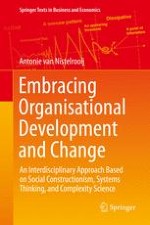2021 | OriginalPaper | Chapter
8. A Complexity Perspective
Consultants Experiences Related to (Their Own) Change Dynamics
Author : Antonie van Nistelrooij
Published in: Embracing Organisational Development and Change
Publisher: Springer International Publishing
Activate our intelligent search to find suitable subject content or patents.
Select sections of text to find matching patents with Artificial Intelligence. powered by
Select sections of text to find additional relevant content using AI-assisted search. powered by
Abstract
-
The historical background of this field, how it relates to change and changing, the contemporary debate in the consultancy literature and its main components as a scientific field of research.
-
How to look at change from a first-person perspective by introducing a narrative, with which we try to make a personal experience meaningful in such a way that the reader can stand in a consultant’s shoes and relate to their own experiences.
-
How research practices such as autoethnographic research and community inquiry can be used as an approach to research to describe and systematically analyse personal interactive experience in order to understand cultural experience in relation to other perspectives regarding this experience.
-
Looking into the first encounters between a consultant and a client, by taking a closer look at the particular challenges and dynamics that are part of the conversations regarding a contracting and the preliminary scoping of the system between a consultant and a client.
-
The concept of a ‘pseudo exploration’, which can cause things to be really complex, giving rise to insurmountable obstructions.
